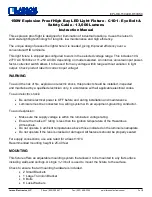
QR 340
Quincy Compressor
50216-105, July 1999
26
3501 Wismann Lane, Quincy IL. - 62305-3116
WARNING !
SUCTION VALVE
UNLOADER ASSEMBLIES
Description
The Quincy suction valve unloader assembly con-
sists of unloading arrangements on the suction valves,
having a plunger to contact the suction valve disc
and an unloader pilot valve (part no.s 110832-***,
and 111422-*** & 111423-***) to automatically regu-
late the passing of receiver pressure to the unload-
ing arrangement.
Application
Suction valve unloader assemblies are recommended
for use on Quincy compressors where the compres-
sor is to run continuously and a constant pressure is
to be maintained. The purpose is to automatically
unseat the suction valve of the compressor when the
air supply is greater than the demand.
Operation
Unloading occurs when receiver pressure is suffi-
cient to overcome pilot valve spring pressure. The
check ball is then unseated, allowing receiver pres-
sure to pass to the unloading arrangements. The
compressor will run unloaded until the receiver
pressure drops to a predetermined level. At this
time, the action of the ball is reversed, shutting off
receiver pressure to the unloader arrangement and
venting the unloader to atmosphere. This allows the
compressor to load. The drive, either electric motor
or combustion engine, runs continuously and must
be started and stopped manually.
Pilot valve 111423-*** can be locked out, for
models equipped with dual control, to provide auto-
matic start/stop operation. The knurled knob at the
top of the pilot can be turned clockwise, until it stops,
to lock it out. A pressure switch is required to stop
the motor. Failure to use a pressure switch, with the
pilot valve locked out, could result in unsafe condi-
tions.
A pressure switch must be incorporated whenever pilot
valve 111423-*** is employed as part of the control system.
The compressor will operate in the continous run
mode if the knurled knob is turned counterclockwise
until it stops.
Installation
The pilot valve is to be connected to the air receiver
using a minimum of 3/8" o.d. copper tube. Compres-
sors in the field, not equipped with a suction valve
unloader assembly, can be converted to constant
speed. Consult your local Quincy Compressor Dis-
tributor for assistance with conversion procedures.
Service
Periodically check the filter & screens in the inlet of
the pilot valve to make sure they are free of obstruc-
tions. If they become clogged, remove and clean or
replace. Inspect the "o"ring located in the opposite
end of the pilot valve body for wear or damage;
replace if necessary.
Adjustment
The unloading pressure is adjustable and is regu-
lated by turning the hex nut (marked "unload adj."
in cross sectional illustrations of pilot valves). Turn
the hex nut clockwise to increase and counterclock-
wise to decrease the unloading pressure.
The differential (difference between unloading
and loading pressure) is set by turning the hex nut
(marked "differential adj." in the cross sectional
illustrations of the pilot valves). Increase the differ-
ential pressure by turning the hex nut clockwise -
decrease by turning counterclockwise. Tighten the
locknuts after adjustment.
CHECK VALVE
ASSEMBLIES
Item
Part
#
Qty.
Number
Description
Check Valve Assembly Replacement Parts
6194X2
Check Valve Assembly
1
1
123157-010 "o"ring
2
1
6196-002
disc
6194X3
Check Valve Assembly
(for use with diester or phosphate ester synthetic lubricants)
1
1
22749-010
"o"ring
2
1
6196-003
disc
2
1





































